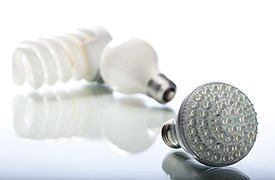 For most people who have spent their adult lives buying classic incandescent light bulbs, they’ve probably looked at a bulb’s wattage rating to determine its brightness. The arrival of the LED light bulb, however, has thrown a monkey wrench into this system of choosing light bulbs, as it has brought attention to the importance of the lumens rating.
For most people who have spent their adult lives buying classic incandescent light bulbs, they’ve probably looked at a bulb’s wattage rating to determine its brightness. The arrival of the LED light bulb, however, has thrown a monkey wrench into this system of choosing light bulbs, as it has brought attention to the importance of the lumens rating.
What are lumens and how are they different from watts? And how does a lumens rating impact your choice of LED (light-emitting diode) lighting for your [city] home?
Fortunately, it’s not all that complicated to understand once you know the difference between the two. But first, let’s start with a little history lesson on watts.
What’s Changed?
Back in the day, when you bought an incandescent light bulb, the watts rating pretty much told you everything you needed to know about how bright a bulb was. Basically, the more watts, the brighter the bulb. Simple enough, right?
As mentioned earlier, the arrival of LEDs changed the rules a bit. A 60-watt LED bulb blows a comparable incandescent bulb out of the water in terms of sheer brightness. In fact, a 60-watt LED is so bright it just might damage your eyes if you looked at it for too long. In addition, the LED equivalent of a 100-watt incandescent light bulb will typically use anywhere between 8 to 15 watts, due to the vastly improved energy efficiency of LEDs.
Simply put, LEDs and to some extent, compact fluorescent lamps (CFLs), make using watts to determine an artificial light source’s brightness useless.
The Solution
As a workaround to this problem, light bulb companies began adopting lumens ratings to indicate a bulb’s brightness, thus giving consumers a more accurate measure of the level of lighting intensity to expect from newer, more energy efficient lighting like LEDs.
What’s the Big Deal with Lumens?
It should be noted, however, that using lumens to measure light is by no means a new concept that arrived along with LED lighting. Lumens ratings have been in use for decades to measure the level of light generated by a light bulb (or any other light source for that matter). Only until recently have they been prominently included in light bulb packaging. The adoption of lumens ratings can also attributed to government intervention, with the US Federal Trade Commission requiring makers of CFLs, incandescent light bulbs, and LED bulbs to use lumens as a guide for consumers.
According to the FTC, while consumers are familiar with watts measurements, which have featured on the packaging of light bulbs for many years, watts are a measure of the amount of electricity used, not brightness. As such, using watts alone to gauge a light bulb’s performance leads to accurate comparisons between newer lighting technologies and incandescent bulbs.
To check an LED light bulbs lumens rating, simply look for the number before “lm,” the abbreviation for lumens. The higher the lumens rating, the brighter the bulb will be. It’s that simple!

![LED Downlights Can Actually Light It Up [city]](https://8blocks.s3.amazonaws.com/eepros/blog-images/2014/09/leddown-300x230.jpg)
![Winter Wonderlands Can Run Up Lighting Bills– But They Don’t Have To [city]](https://8blocks.s3.amazonaws.com/eepros/blog-images/2014/11/park-lights-300x183.jpg)
![A Crash Course on Using LEDs in Your [city] Home [city]](https://8blocks.s3.amazonaws.com/eepros/blog-images/2016/02/light-bulbs-407239_640-300x200.jpg)
![CFL Light Bulbs: Are they the Right Option for You? [city]](https://8blocks.s3.amazonaws.com/eepros/blog-images/2015/06/bulb-301747_640-300x225.jpg)